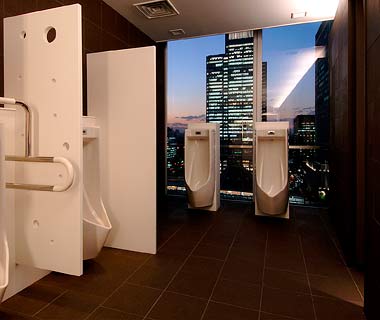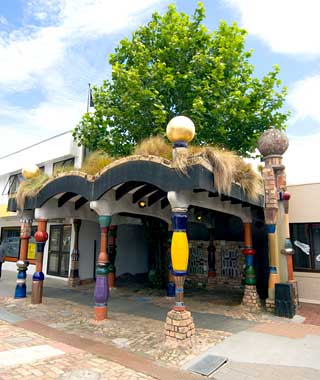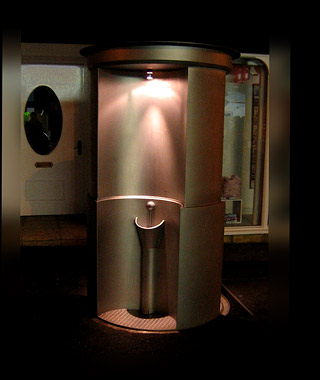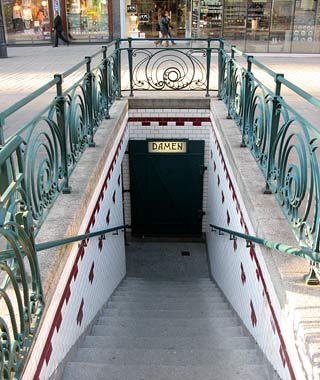World’s Greatest Public Bathrooms
Visitors to the John Michael Kohler Arts Center in Sheboygan, WI, are awed by The Social History of Architecture, by contemporary artist Matt Nolen. They carefully study the work’s iconography, admiring the bold colors and skilled brushstrokes.
But this isn’t a painting or sculpture. It’s one of six washrooms created by individual artists under the center’s Art/Industry program, and it’s a must-see—and must-use—for museumgoers. In fact, for some of those in need, the fact that this is actually a nice, clean, and inviting public toilet trumps its artistic merits.
A high-quality public bathroom ranks high on the list of travelers’ necessities. These go-to johns generate fervent blog posts and are the subject of contests around the world, including the annual America’s Best Restroom competition. They can be as sought after as any insider find: a secret beach, a flea-market bargain, the best little neighborhood restaurant.
So what constitutes a “nice” public toilet? A full stock of bathroom tissue, unclogged plumbing, and smear-free surfaces are the most basic criteria. But the best go beyond the call of duty and are paragons of creativity—destinations in their own right. Tourists consider the trek to Kawakawa, a small town in New Zealand’s Bay of Islands, a worth-it detour to get a glimpse of Friedensreich Hundertwasser’s outrageous facilities, decorated with glass bottles and colorful mosaics.
Other great public loos incorporate cutting-edge technology. The ingenious Urilift, popping up (literally) in cities all over Europe, comes out only during the night, when the streets are filled with carousers, then discreetly retracts into the ground.
The bathrooms at Daimaru department store in Tokyo are equipped with programmable Washlets from Japan’s leading toilet company, Toto. The functions include a heated seat and a bidet wand that spritzes and dries your backside, all to the soothing sounds of running brooks or crashing ocean waves.
These facilities’ thoughtful and innovative approaches to one of life’s essential functions are highly appreciated. Keep this list of top toilets handy for your next trip; you never know when you’ll need a pit stop.

Hundertwasser Public Toilets, New Zealand
Kauri forests, turquoise waters, and a cove-studded coast top the list of attractions in New Zealand’s Bay of Islands, but the colorful Hundertwasser Public Toilets are a surprising draw. Built in 1997, these loos are the architect and artist Friedensreich Hundertwasser’s wacky version of a temple (bathrooms are places of contemplation after all, he has noted), with curvy columns, shardlike mosaics, and “stained glass windows”—walls embedded with vividly hued glass bottles. The eco-smart building incorporates a living tree, a grass roof, and reclaimed bricks.
Where to Go: These johns are on State Highway 1, north of Paihia, in the rural township of Kawakawa.

Urilift Pop-Up Toilets, Europe
These stainless-steel cylinders are Europe’s solution to a pervasive (and odoriferous) problem. “Indiscriminate urination. You come across it in just about every city, town and village” is how Urilift’s promotional video describes it. Timed to rise from the ground during the wee hours, peak times for staggering revelers, they serve as convenient, easy-aim receptacles. And the floor contains a drainage unit in anticipation of the more poorly coordinated (or inebriated) visitors.
Where to Go: Urilift is in Cambridge Circus in London, Rembrandtplein in Amsterdam, Shaftesbury Square in Belfast, and other cities around Europe.

Graben Toilets by Wilhelm Beetz, Vienna
The late 19th century marked a turning point in Vienna’s sanitation history, thanks to one Wilhelm Beetz. The city’s long history of crude and infection-prone facilities (wooden buckets, anyone?) drove Beetz to propose a number of modern conveniences, including these Jugendstil toilets in Graben, the shop-to-be-seen boulevard of fin de siècle Vienna. The entranceway—framed by twisting metalwork—is reminiscent of a subway gate, but descend and you’ll find elegant underground toilets with pretty patterned tiles, marble walls, and wood-paneled booths equipped with individual sinks and brass fixtures—still spic-and-span.
Where to Go: Graben street, near Kohlmarkt, in the heart of historic Vienna.



